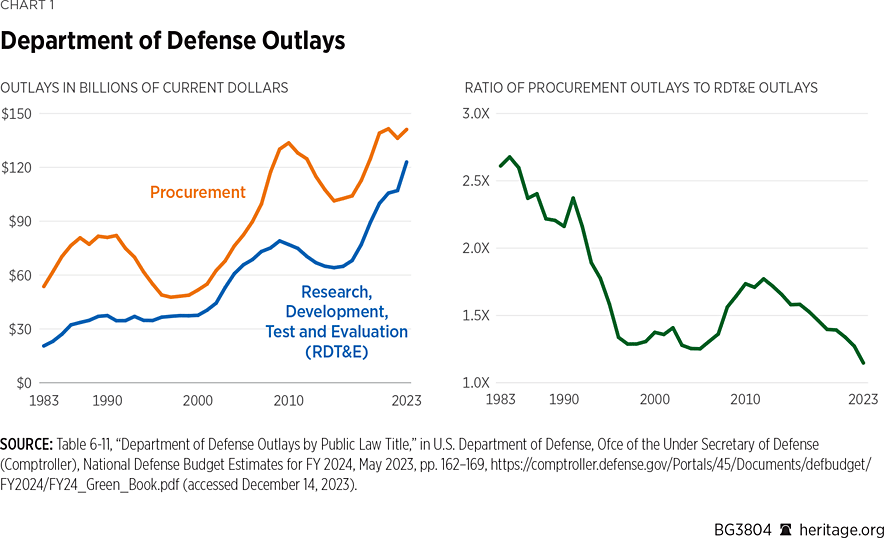Imagine that the Ford Motor Company spent almost as much on research and development as it does on building cars. That would not be a workable model: Showroom floors would stand half empty, shareholders would lose money, Americans would not be able to buy cars, the company would go out of business, and competitors would quickly take up its market share. People would find it preposterous that Ford was investing more in paying the salaries of scientists to develop a car that could not be sold for another decade than it was in building the F-150s and Mustangs of today. For reference, Ford spent $7.8 billion in 2022 on research and developmentREF compared to $90 billion to procure parts for production.REF
In fiscal year (FY) 2023, the U.S. Department of Defense (DOD) was authorized to spend $140 billion for research, development, testing, and evaluation (RDT&E) and $167 billion for procurement, making RDT&E equal to about 84 percent of procurement. From FY 2022 to FY 2023, RDT&E combined budget authority increased by $21 billion, and procurement spending increased by about $13.5 billion. From FY 2021 to FY 2022, spending on RDT&E increased by $13 billion, and spending on procurement increased by $4.7 billion.

In other words, the U.S. Department of Defense is spending $34 billion more on research and development than it was two years ago and has increased spending on the procurement of new aircraft and ships only by about $18 billion. It would seem that congressional appropriators have decided that in the 2020s, research and development of future systems to be used in the 2030s is about twice as important as buying F-35s and Virginia-class submarines that can be used this decade. This prioritization of RDT&E might have been a reasonable position in the 1990s, but Washington in 2023 is expecting a major conflict sometime this decade, with many predicting a confrontation with China over Taiwan before 2027. If that is the case, why is the government not prioritizing spending on systems that the U.S. military might need in the next couple of years?
The disparity is much larger within the individual departments. In 2017, the Department of the Air Force (DAF) began to enjoy real budget growth that was not associated with a contingency for the first time in more than 26 years.REF From FY 2017 to FY 2023, the DAF’s budget increased by 54 percent, giving the service the opportunity to increase procurement to acquire the number of weapons systems required to compete with a rising China.REF Bafflingly, it chose instead to devote the vast majority of that increased funding to RDT&E, which grew from $19.6 billion to $50.5 billion while funding for procurement grew from $22.4 billion to $34.1 billion—a comparatively slight increase. Before 2017, the Air Force’s budget for RDT&E had never exceeded its budget for procurement, but it has done so every year since then, and in FY 2023, funding for RDT&E ($50.5 billion) exceeded funding for procurement by $16.4 billion.REF
The other services have similar problems. The Army, for example, has not fielded a major new combat system since the 1970s despite having a substantial RDT&E budget of its own.REF
With the prospect of conflict in the Indo-Pacific so close at hand, and with the U.S. being pulled in multiple directions, RDT&E projects need to be as concentrated on direct military capability as possible. The last time America faced such a threat was at the height of the Cold War, and the U.S. military was rightly focused on building capacity with the most modern, fieldable technology it could find. From FY 1980–FY 1990, the DOD budget for procurement more than doubled the budget for RDT&E with procurement peaking at $213 billion in FY 1985 (in constant FY 2024 dollars).REF In that year, 34 percent of the defense budget was allocated to procurement; by 2017, procurement had fallen substantially to 20 percent.REF The U.S. military neglected procurement throughout the wars in Iraq and Afghanistan, and operations and maintenance (O&M) costs skyrocketed as the military was forced to maintain steadily aging systems.
In FY 2023, the Defense Department’s budget of $140 billion for RDT&EREF is not even related entirely to defense. Those who complain about bloated defense budgets should take note that lawmakers enjoy forcing the DOD to spend money on science projects in their home districts that are conducted by post-doctoral students at large universities and have either only a tenuous connection or no connection at all to the defense priorities outlined by the National Defense Strategy. Lawmakers know that the annual National Defense Authorization Act (NDAA) is the one law that is essentially guaranteed to pass every year, and some do their best to sneak in money for home districts and states or even for donors.
Ford Motor Company is beholden to its shareholders and much too smart to engage in this kind of wasteful spending. Unfortunately for both the American taxpayer and the American soldier, the Department of Defense is not prioritizing its spending to support the current national defense strategy. Some of the blame rests with the Pentagon itself, but much of it rests with Congress.
The Strategic Context
In the 2030s, it may be too late to address this problem effectively. The military competition with China is a matter of far greater urgency than many in Washington believe. Numerous senior military officials have commented on the near-term threat that China poses as it works to complete its military modernization by 2027 in time for the 100th anniversary of the People’s Liberation Army (PLA). For example:
- Admiral Philip Davidson commented on this acceleration by the Chinese in his testimony before the Senate Armed Services Committee in 2021. He argued that China was accelerating its military development with a view to becoming a “world-class” military ahead of the 2035 goal originally set by Beijing through heavy investment in forces supporting China’s anti-access/area denial (A2/AD) capabilities, the People’s Liberation Army Navy (PLAN), and the People’s Liberation Army Air Force (PLAAF). He cited the advanced warships and fifth-generation fighters China is building as examples of its growing capability and warned that China could invade Taiwan by 2027.REF
- Earlier this year, Air Force General Mike Minihan asserted that the U.S. and China could be at war as early as 2025: “I hope I am wrong. My gut tells me we will be at war in 2025.”REF While not necessarily predicting it will happen, General Minihan stressed the growth in Chinese capabilities and the fact that U.S. forces are not ready to fight the type of war necessary for a conflict with China in the Pacific. His prediction was meant to be a call to arms to U.S. forces to step up training and preparation, take more risk in training, and take the threat seriously.
Not only has China overtaken the U.S. numerically in such categories as the number of warships in each navy, but the ships China is building are increasingly advanced, degrading the American technological advantage. Beijing’s shipbuilding investment has raised China’s fleet to around 355 ships, and that number is expected to grow to about 420 by 2025. China’s ships are also more capable than the earlier versions launched by the PLAN. For comparison, the total U.S. fleet is approximately 290 ships, about 60 of which are deployed to the Indo-Pacific at any given time given that, unlike China, America is also an Atlantic power and must deploy assets in that ocean as well. China has a numerical advantage and as it closes the technology gap will become increasingly dangerous. When its gains in nuclear, air, and A2/AD capabilities are factored in, China represents a formidable threat to the U.S.
It is not possible to know exactly how much China spends on its own RDT&E, because the Chinese government claims that Chinese military spending is subsumed within their published equipment budget. Given the rate of China’s military growth over the past several decades, this is almost certainly not true, and China is likely conducting significant RDT&E off the books.REF Moreover, China engages in intellectual property theft against the United States and other nations and conducts a significant amount of RDT&E using ostensibly civilian organizations.REF
As Heritage points out in the 2024 Index of U.S. Military Strength, the U.S. military “is at significant risk of not being able to meet the demands of a single major regional conflict” because of capacity, modernization, and readiness challenges across the services.REF The Navy does not have nearly enough ships to cover its global demands, let alone adequately cover China in the Pacific where it would face the entirety of its fleet, and the U.S.’s supply of precision munitions is woefully short of what it would need to fight a peer competitor. This creates a scenario in which China has robust military capabilities coupled potentially with the intent to use them, and the U.S. currently lacks the credible hard power to deter China effectively in the short term.
One of America’s most important allies in the region certainly thinks immediate procurement is necessary. The Japanese have built their current defense spending around the presumption that a major conflict is possible sometime before 2027 and have therefore de-emphasized RDT&E in the short term, instead focusing their defense spending on optimizing Japan’s current authorized strength; obtaining the equipment and munitions (especially air and missile defense and standoff missiles) that would be needed to fight a war in 2027; and making procurement more cost-efficient to enable more of it in the short term.REF
Spending Priorities
If any Members of Congress were to propose a large cut in RDT&E with an accompanying increase in procurement, the predictable opposition argument would be that the RDT&E budget is how the United States keeps its advantage over the rest of the world by developing cutting-edge military technology. But this argument presupposes (1) that every dollar of the RDT&E budget is being spent wisely and (2) that procurement of current systems is not a higher priority.
There are large amounts of non-defense spending within defense RDT&E. Some of it might be useful if it were being done by a more suitable government agency, and some of it should be cut from the federal budget entirely. Either way, the DOD should not be tasked with conducting non-defense missions. The goal of the Department of Defense is to build and maintain a military that is capable of defending the American people, and when it is tasked with non-defense lines of effort, it is distracted from this mission. The following are examples of this questionable non-defense spending.
- The DOD is spending almost $1 billion annually on medical research. Some of this money supports research on diseases that are relevant to the DOD, but much of it funds research that has no connection to national defense whatsoever and should be conducted by the National Institutes of Health (NIH).REF
- One of lawmakers’ favorite additions is funding for Centers of Excellence (sometimes co-located with major universities in their home states) that were not requested by the Department of Defense itself and often have only the most tenuous connection to defense research.REF
- Conservative lawmakers should be distressed to learn that there is a Defense Equal Opportunity Management Institute.REF
- There is also a huge amount of generic science, technology, engineering, and mathematics (STEM) support going to universities (a function better served by the private sector), as well as large lines of funding designated for certain schools for political reasons.REF
Some self-defined defense hawks might argue that the DOD could afford to spend all the money it is currently spending on RDT&E while increasing procurement. Given the recent fights over the defense topline and the urgent need for budget cuts across the board, however, it is very unlikely that there will be a dramatic increase in the defense budget topline next year. Even if there were, no politically feasible topline increase would contain enough money for the procurement of the weapons systems and munitions necessary to deter China in the Indo-Pacific in the short term. Therefore, a large amount of the necessary procurement funding must come from elsewhere in the existing defense budget. More important, given the current fiscal condition of the United States, it is always right to spend federal resources as wisely as possible.
If the United States does fight a war with China in the 2020s, or even in the 2030s, that war will be fought with largely the same technology that exists now. Policymakers need to move now to acquire those weapons systems in large quantities.
This paper does not argue that no RDT&E spending is important: To the contrary, legitimate RDT&E must be continued on the sixth-generation Next Generation Air Dominance (NGAD) platform; the Virginia-class replacement (the SSN(X)); the yet to be fielded B-21; the DDG(X) destroyer; the FFG(X) frigate; and other classified programs that further the combat systems that can be fielded in the near term. But these programs and other major defense initiatives do not seem to form the bulk of RDT&E spending. NGAD, for example, is one of the RDT&E programs most cited by the Administration and the DOD as a critical program of the future that will revolutionize air war.REF For FY 2024, the Air Force requested only $2.3 billion for NGAD research, and the Navy requested only $1.5 billion.REF Even when one considers the likely masked (classified) funding and the smaller line items that are related to NGAD, the annual funding for this sixth-generation fighter is a small percentage of FY 2024’s $140 billion RDT&E budget.
We assess that the DOD should retain more than $100 billion for research and development. That is more than enough for the major platforms and capabilities under development now, to include the Next Generation Air Dominance Fighter, the next-generation bomber (B-21), the Virginia-class replacement, and a number of other critical programs. Moreover, the most advanced of these developmental programs will not deliver combat platforms in number until the late 2020s, and most will not come of age until the mid-2030s. We need more destroyers, more fighters, and more munitions far sooner than that.
Congressional Additions
Members of Congress love to blame the Pentagon for wasteful spending and mismanagement while ignoring the fact that many of the worst examples in the defense budget are in fact congressionally directed lines of effort that were not requested by the Department of Defense.
The process for building the annual budget for the Defense Department, known as Planning, Procurement, Budgeting, and Execution (PPBE), is driven by the operational requirements of the services. However, the legal authority to spend that money is written into the NDAA, and the congressional process that builds that document is equally involved and heavily influenced by politics. In some cases, politicians will authorize spending not requested by the Office of the Secretary of Defense that will enhance military capabilities such as additional fighter aircraft or munitions. More often than not, however, politicians will add lines that serve their constituents or a pet political agenda that will have no positive impact on military capabilities. Examples of those wasteful RDT&E authorizations run the gamut from the previously mentioned university STEM programs to developing sustainable (but cost-prohibitive) fuels that further environmental agendas. Removing those authorizations and replacing them, dollar for dollar, with additional authorizations for procurement and readiness would significantly bolster military readiness without adding additional deficit spending.
Recommendations
With the foregoing facts in mind, Congress should:
- Reduce RDT&E authorizations/spending by $40 billion over a period of no more than three years. RDT&E funding should be reduced by $20 billion in FY 2025, $10 billion in FY 2026, and an additional $10 billion in FY 2027. With the exception of NGAD, RDT&E funding should be continued only for programs beyond technical readiness level six (TRL-6) and programs that can begin operational fielding by 2028. Funding reductions should be prioritized so that promising technologies that do not make both readiness and timing thresholds can shift methodically to a caretaker status.
- Shift funding saved through RDT&E reductions to procurement and O&M (readiness/combat employment training). The funding should be increased/applied at a ratio of 80 percent and 20 percent, respectively.
- Direct the service chiefs to build their respective RDT&E budgets to comply with this guidance and to identify and annually report every dollar that is being spent on initiatives that do not further military capabilities in an unclassified, publicly releasable report to Congress. This includes but is not limited to university STEM research initiatives; research on environmental and global warming issues; and research on race, gender, or other social engineering issues.
- Adopt a presumption of denial for funding of RDT&E projects past a certain date. Specifically, RDT&E projects should have to apply for a continuation of funding if they are unable to move past the research phase within three years. Long-term projects such as NGAD would of course receive approval to continue past this date, but smaller RDT&E projects would be placed under more intense scrutiny. This would enable program managers to pick out initiatives that are not moving quickly enough toward development, that were unlikely to produce a concrete result at all, or that were costing too much and draining resources from more immediate priorities.
Conclusion
The Department of Defense needs to move immediately to build war-fighting capacity, capability, and readiness that deters China’s increasingly aggressive military activities and, should that deterrence fail, defeat them in a war that takes place within the next five years. That move must begin immediately, and the most fiscally executable strategy to fund that effort is to shift RDT&E funding to defense procurement and readiness accounts that will field a fighting force that once again strikes fear in the heart of our enemies.
Wilson Beaver is Senior Policy Analyst for Defense Budgeting in the Douglas and Sarah Allison Center for National Security at The Heritage Foundation. Robert Peters is Research Fellow for Nuclear Deterrence and Missile Defense in Allison Center. John Venable is Senior Research Fellow for Defense Policy in the Allison Center. James Di Pane is a former Policy Analyst for Defense Policy in the Allison Center.





